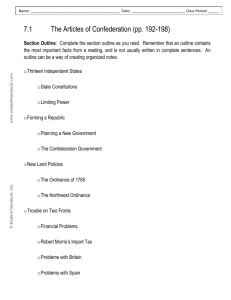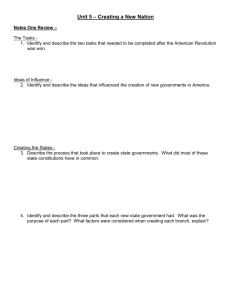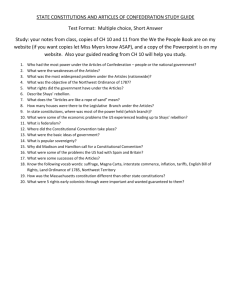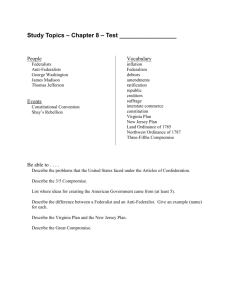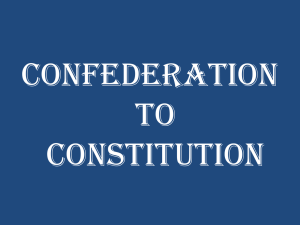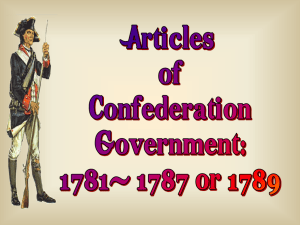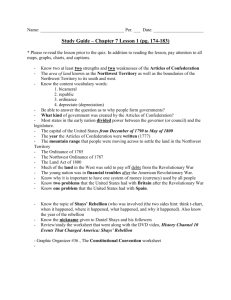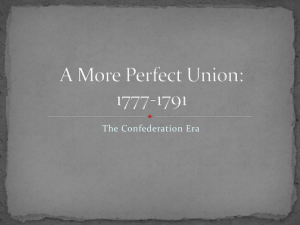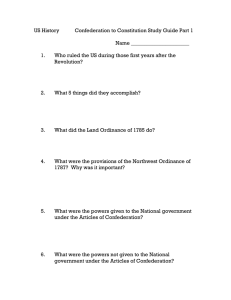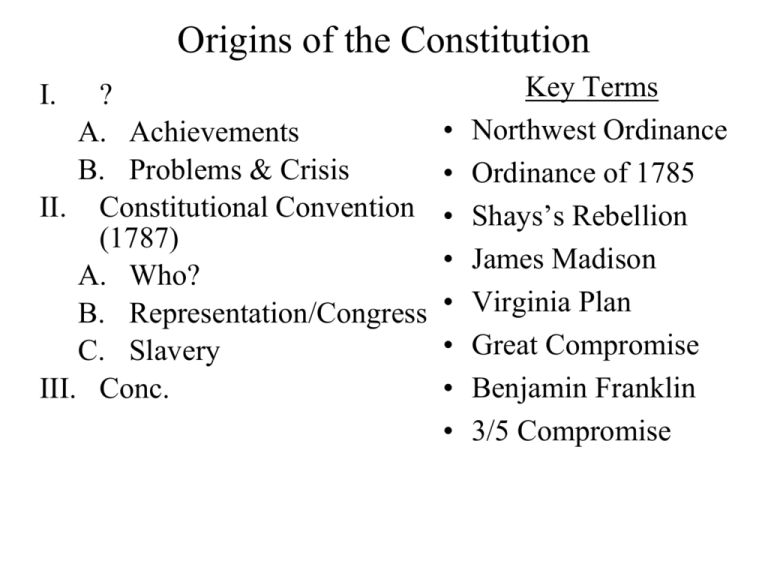
Origins of the Constitution
I.
?
A. Achievements
B. Problems & Crisis
II. Constitutional Convention
(1787)
A. Who?
B. Representation/Congress
C. Slavery
III. Conc.
•
•
•
•
•
•
•
•
Key Terms
Northwest Ordinance
Ordinance of 1785
Shays’s Rebellion
James Madison
Virginia Plan
Great Compromise
Benjamin Franklin
3/5 Compromise
Origins of the Constitution
I.
Articles of Confederation
A. Achievements
B. Problems & Crisis
II. Constitutional Convention
(1787)
A. Who?
B. Representation/Congress
C. Slavery
III. Conc.
•
•
•
•
•
•
•
•
Key Terms
Northwest Ordinance
Ordinance of 1785
Shays’s Rebellion
James Madison
Virginia Plan
Great Compromise
Benjamin Franklin
3/5 Compromise
Articles Of Confederation
1. First US Constitution
2. Created a national
legislature to pass laws
Key Philosophy = State’s
Rights
Articles of Confederation
Image Copyright © Houghton Mifflin Company. All rights reserved.
Ordinance Of 1785
• Dealt with land in Northwest Territory
• Provided process to sell & distribute public
land
1. Public land was divided into Townships 6 mi²
2. Each Township was divided into 36 Sections;
each 640 acres or 1 mi²
3. Each Section could be purchased for $1 per
acre (or $640)
Ordinance Of 1785
(Legacy = Local Townships)
Northwest Ordinance
(1787)
Gave process for new states to join the Union
1. Territories = one Representative in Congress
when population reached 5,000 voters
2. Territories could apply for statehood when total
population reached 60,000
3. Freedom of religion & trial by jury were protected;
slavery was prohibited in Northwest Territory
Problems With the Articles of
Confederation
1. Each state had one vote
(regardless of its population)
Articles of Confederation
Problems With the Articles of
Confederation
Concept: One State/One Vote
• Virginia = 750,000
• Delaware =
60,000
Original 13 States And Territories
Image Copyright © Houghton Mifflin Company. All rights reserved.
Problems With the Articles of
Confederation
1. Each state had one vote
(regardless of its population)
2. States could coin their own
money & conduct foreign
policy
3. Instability led to a crisis….
Articles of Confederation
Shays’s Rebellion
(1786-87)
General Daniel Shays, Colonel
Job Shattuck, Artist Unknown
• Farmers in
Massachusetts faced
economic hardships
• Daniel Shays led an
“army” of 2,000 angry
men
• Rebellion = crushed; but
there was near anarchy
• Impact: demonstrated
the weakness of the
national government
Image Copyright © Houghton Mifflin Company. All rights reserved.
Which individual had the greatest
impact on the Constitution…?
James Madison
Who was NOT at the Constitutional
Convention?
Thomas Jefferson
Jefferson was the US
Ambassador to France
Virginia Plan (Madison)
James Madison
1.
Eliminate the Articles of
Confederation
2.
Separate the National
Government into three
branches: Legislative
(most powerful), Executive
& Judicial
3.
Representation in the
Legislative Branch would
be determined entirely by
a state’s population
Separation of Powers
Legislative
(most powerful)
The number of
Reps for each
state is
determined by a
state’s
population.
Executive
Judicial
Great Compromise
• Separate the Legislative
Branch into two sections:
– House of
Representatives (based
on population)
– Senate (two for each
state)
Ben Franklin
Great Compromise (Franklin)
Legislative
House of Representatives
•Based on population
Senate
•Two for each state
Executive
Judicial
Michigan’s 15
Congressional
Districts
Today, each district
represents about
650,000 people
Michigan’s Elected Representatives
Pete Hoekstra
US House
Debbie Stabenow
US Senate
Carl Levin
US Senate
Controversy: How to Count Slaves?
Solution = 3/5
Compromise
• One slave is equal to 3/5
of a person when
determining a state’s
population
Origins of the Constitution
I.
Articles of Confederation
A. Achievements
B. Problems
II. Constitutional Convention
(1787)
A. Who?
B. Representation/Congress
C. Slavery
III. Conc.
•
•
•
•
•
•
•
Key Terms
Northwest Ordinance
Ordinance of 1785
James Madison
Virginia Plan
Great Compromise
Benjamin Franklin
3/5 Compromise

